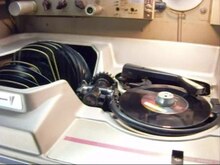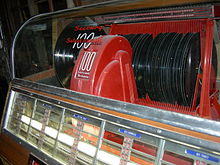Jukebox
A jukebox is a machine that plays music by inserting coins . In German, the term “music box” is also used. The term jukebox comes from the Creole language area and is derived from “jook” or “juke”, which describes humorous obscene music, dance or language .
history
The predecessor of the jukebox, also jokingly known as the "Groschengrab", was the automatic phonograph , a jukebox that played music from a wax cylinder. The devices were produced in large quantities from 1889 onwards, after Louis Glass had demonstrated such a public on November 23, 1889 in the Palais Royal restaurant in San Francisco. The first phonographs could only play short, mostly two-minute pieces with poor sound quality. That later changed with the invention of the shellac record, which increased the length to around three to three and a half minutes.
In the 1930s and early 1940s, the name Coin-Operated Phonograph was officially used; It was not until 1946 that the term jukebox established itself with the AMI A ( Mother of Plastic ) model . In 1936 the Rudolph Wurlitzer Company was the market leader in the USA with an annual production of nearly 45,000 units. Since the 1940s, which was vinyl plate used as a more durable storage medium in the late 1940s, the first already arrived Single -Schallplatten (speed: 45 / min) on the market. Due to the GIs stationed in Germany , the jukebox also became popular in German-speaking countries in the 1950s. The breakthrough came in the course of rock 'n' roll with performers such as Elvis Presley or Bill Haley .
The classic jukeboxes of the 1940s - also known as the "Golden Age" - came predominantly from US manufacturers such as the Rudolph Wurlitzer Company, J. P. Seeburg , Rock-Ola , Evans or Automatic Musical Instrument Corp. (AMI). The design was characterized by large, colored and illuminated pilasters made of plexiglass. The interchangeable mechanism was not visible on some models (Seeburg).
Between 1941 and 1947, the Mills Novelty Company produced special film jukeboxes on which short music films, the so-called soundies , could be played. The emergence of television prevented these devices from spreading further.
In the 1950s - the "Silver Age" - stylistic elements of vehicle design were increasingly adopted (tail fins, panorama windows, taillights, etc.) Preferred materials were chrome and glass.
Jukeboxes have been an important part of pop culture for decades. They were also sung about in hits such as Juke Box Jive ( Rubettes , 1974), Juke Box Music ( Kinks , 1977) and Juke Box Hero ( Foreigner , 1981).
German manufacturers such as Tonomat, Wiegandt, NSM-Löwen and Bergmann have been producing since the early 1950s. Production began in the GDR at the end of 1959. The appearance of these devices was usually more reminiscent of furniture in the style of the time . However, there were also exceptions such as the Telematic and Panoramic models from Tonomat.
In the early 1960s, Deutsche Wurlitzer was opened in Hüllhorst as a subsidiary of the Wurlitzer Company (USA). The Harting company , whose jukeboxes had previously been sold by Theo Bergmann (Hamburg), founded a German branch in the mid-1960s.
In the 1980s - together with the change in leisure behavior - the spread of personal players with compact cassettes ( Walkman , followed by portable CD players ) led to the decline of the industry.
There has been an active collector's scene in Germany since the Rock'n Roll Revival of the 1980s. The largest trade fair in Europe is the Rock Around The Jukebox , a two-day event that has been held annually at the Autotron technology museum in Rosmalen (Netherlands) since 1988 . Restored jukeboxes include a. can be seen in the Rockmuseum Munich , the Rundfunkmuseum Fürth and the Deutsches Museum in Munich.
Production of jukeboxes in the GDR
In the GDR , the production of jukeboxes began in 1960 after the devices previously imported from the USA had been consumed. The basis was a decision of December 1, 1959, after jukeboxes were required in the GDR. The first type 80 A device , manufactured by KG Görner, was presented at the Leipzig spring fair in 1960 . In contrast to the western brands, this jukebox had a double-sided vertical playback of the 40 single records, so 80 different songs or hits could be played at the push of a button. The devices were also exported to a dealer in Sweden. However, only fewer than 50 devices could be produced during that time because the capacity of the factory was insufficient. In 1962, therefore, the production of an improved design was transferred to the Funkwerk Erfurt . The jukebox was now considered a consumer good. The new model, type 80 B , had a tube amplifier output stage of 10 watts and was thus able to fill larger rooms with music. The Polyhymat 80 C model shown in the picture did not receive a quality mark because, for example, the external voltage distance and annoying rumbling noises did not meet the requirements. The design of the 1960s was the successor model 80 D reached. On March 12, 1966, the 1000th Polyhymat left the Funkwerk Erfurt. There was stereophony with the 80 E model . The Polyhymat 80 F was a completely new design in 1967 . As has been customary in the West for decades, horizontal playback of the records was reintroduced. The record magazine now had 80 singles, the amplifier now had two-way loudspeaker boxes that were highlighted in terms of design and a simpler housing. However, there was no longer any series production because semiconductors were to be manufactured in the Funkwerk Erfurt . Around 1,500 jukeboxes were manufactured in the GDR and were serviced by the manufacturer until the end of the GDR.
Structure and technology
Special technical challenges lay in the coin check, the selection mechanism and the playback unit. A jukebox contains between 8 and 120 shellac records , singles , more rarely cassettes and from 1982 also compact discs , from which one or more titles can be selected after inserting a coin using a keyboard or a rotary dial .
Until the early 1960s, the visible pick and play automatics dominated; then it increasingly disappeared behind the titleholders or a brightly printed pane of glass. The music was played via built-in tube amplifiers and speakers; These components were often bought in from outside companies such as Philips or Klein and Hummel for German devices . Transistor amplifiers have also been used since the early 1970s .
See also
literature
- Luc Wildschut: Jukebox Heaven, Ger Rosendahl .
- Christopher Pearce: Vintage Jukeboxes - The Hall Of Fame . Quantum, 1988, ISBN 0-7858-0785-3
- Dieter Ladwig: Jukebox - music from the machine . Paul Zsolnay Verlag, 1993
- Ian Brown, Nigel Hutchins, Gerry Mizera: The Ultimate Jukebox Guide 1927–1974 . Pla-Mor Press, 1994, ISBN 0-9524070-0-0
- Michael Adams, Jürgen Lukas, Thomas Maschke: jukeboxes . Battenberg, Augsburg 1994, ISBN 3-89441-167-8 , English edition: Jukeboxes . Schiffer, 1996, ISBN 0-88740-876-1
- Werner Reiss: Johann Strauss meets Elvis, music automatons from two centuries (= series of publications of the Preussen-Museum Nordrhein-Westfalen, publication 4), Arnoldsche, Stuttgart 2003 ISBN 3-89790-188-9 OCLC 52308588 .
- Hildegard and Oliver Stamann, Dirk Werner: Jukeboxes on Location . Jukebox World, 2012
Web links
- Talking machines and music boxes . From: When the penny falls , book for the exhibition of the same name in the Deutsches Museum
- Danish Jukebox Archives (English)
- Jukebox-World - pictures of American and European jukeboxes
- Jukebox Locations - Pictures and reports from jukeboxes in public locations
- Jukeboxes on location - pictures, photos and postcards - yesterday and today
- Additional devices for jukeboxes or jukeboxes from the 1950s
- Jukebox wiki at Wikia with lots of interesting tips, instructions for repairs
- Serial number database
- Musikboxenverein e. V. - First German jukebox club for lovers of jukeboxes and accessories and those who want to become one
- GDR music boxes
Individual evidence
- ^ Gert J. Almind: Jukebox History 1888–1913 of the Danish Jukebox Archives (English).
- ↑ youtube.com Soundies on a restored Mills Panoram
- ↑ jukebox-world.de jukeboxes of the GDR.
- ↑ History of the Polyhymat (PDF) jukebox-world.de
- ↑ jitterbuzz.com Mechanics of the jukeboxes (English).
- ^ Catalog of an exhibition held at the Preussen-Museum Nordrhein-Westfalen, Minden (Mar. 30-June 29, 2003) and Wesel (Sept. 21-Nov. 16, 2003).




